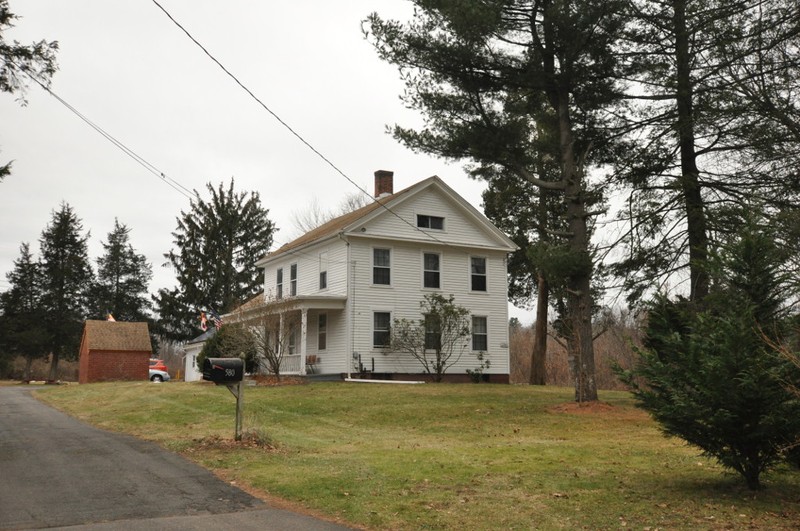Edward L. Burnham Farm
Introduction
Text-to-speech Audio
Images
Edward L. Burnham Farm

Backstory and Context
Text-to-speech Audio
In 1861 when the Burnham family planted potatoes and grains and tobacco for sale, this farm spanned 100 acres. While the farmhouse has been well-preserved, the farm now includes less than two acres. Still, the country Greek Revival house and barns survive as a reminder of an era when farming, notably tobacco farming, proliferated in Connecticut. It also points to an area of transition when family farming gave way to the commodification of soils in terms of highly commercialized farming.
Native Americans successfully grew and harvested tobacco in the Connecticut Valley well before European settlers arrived in the 1630s. The introduction of broadleaf tobacco (mainly used for cigar production) emerged in Connecticut during the 1830s -- the earliest account came in 1833. Although, extensive cultivation of broadleaf tobacco did not transpire until the 1850s. By the dawn of the Civil War, Hartford County stood as one of the nation's top cigar-tobacco producers. Thus, it comes as no surprise that Edward Burnham (1842-1904) included broadleaf tobacco among his crops after purchasing his 100-acre farm from a relative in 1861.
In truth, he only dedicated a small portion of his farm (a little more than an acre) to tobacco during his first few years of working the fields. In 1870, data shows Burnham harvested 2,200 lbs of tobacco on that small section, but he also profited from grain, potatoes, orchard products, hay, and butter production. By 1880, the growth of nearby towns led Burnham to purchase more cows to meet the increased demand for milk and butter. Still, he also doubled his tobacco production, growing it on three acres of land and yielding nearly 5,000 lbs. Tobacco farming required intensive labor, was expensive to cultivate, yet it accounted for almost half of Burnham's entire profit from crops.
In 1903, the Burnham family constructed a five-acre tobacco barn, followed by an eleven-acre barn around 1918. The barn served as demonstrations for the farm's success, but by the 1910s, the family leased much of its farmland to commercial growers, a trend that gained tremendous momentum throughout the twentieth century. Even by 1923, two large growers controlled most of the 1,000 acres of farmland in Manchester.
Many of the farm buildings remained until late in the twentieth century, which offered onlookers a lens into the world of agricultural history, notably from a technological viewpoint. The prevalence of dairy products could be seen in the farm's ice house and milk (dairy) houses. The barns consisted of thick walls, double roofs, sawdust insulation, fully sheathed interiors, and minimal openings as part of the farm's refrigeration and insulation techniques. As noted in the nomination form to the National Register of Historic Places, "The two buildings were part of almost every 19th-century farm, and yet today are probably rarer than barns." Sadly, they are also gone at the farm. But, the barns offered for some time evidence to modern academics a view into the tobacco farming evolution, too. The 1918 barn included horizontal openings intended to create convective currents, helping dry the tobacco, a vast improvement to barns in the 1880s with vertical board siding.
Though much of the farmland was sold, the house remains along with pictures and accounts of those who lived here. To view the house is to view a bit of farming history, both in terms of tobacco growth and the transition from family farming to commodity farming. Furthermore, the slow decimation of the farm speaks to a different culture that sees land as a place for suburban housing, roads and highways, and other structures typical of the late twentieth century into the twenty-first century -- the different choices in how the land is used speaks to the broader culture.
Sources
Anderson, P.J. "Growing Tobacco in Connecticut." The Connecticut Agricultural Experiment Station Bulletin 564. ct.gov. January, 1953. https://portal.ct.gov/-/media/DEEP/pesticides/Certification/Applicator/PATobaccoManualpdf.pdf.
Clouette, Bruce. "Nomination Form: Edward L. Burnham Farm." National Register of Historic Places." nps.gov. April 12, 1982. https://npgallery.nps.gov/GetAsset/ad8fda93-12d9-433b-b147-def5eabc5a0b/.
Marx, Leo. The Machine in the Garden: Technology and the Pastoral Ideal in America. New York: Oxford University Press, 2000, 1964.
Percy W. Bidwell. "The Agricultural Revolution in New England." The American Historical Review 26, no. 4 (1921): 683-702.
Steinberg, Ted. Down to Earth: Nature's Role in American History. New York: Oxford University Press, 2000.
By Magicpiano - Own work, CC BY-SA 4.0, https://commons.wikimedia.org/w/index.php?curid=64997058
